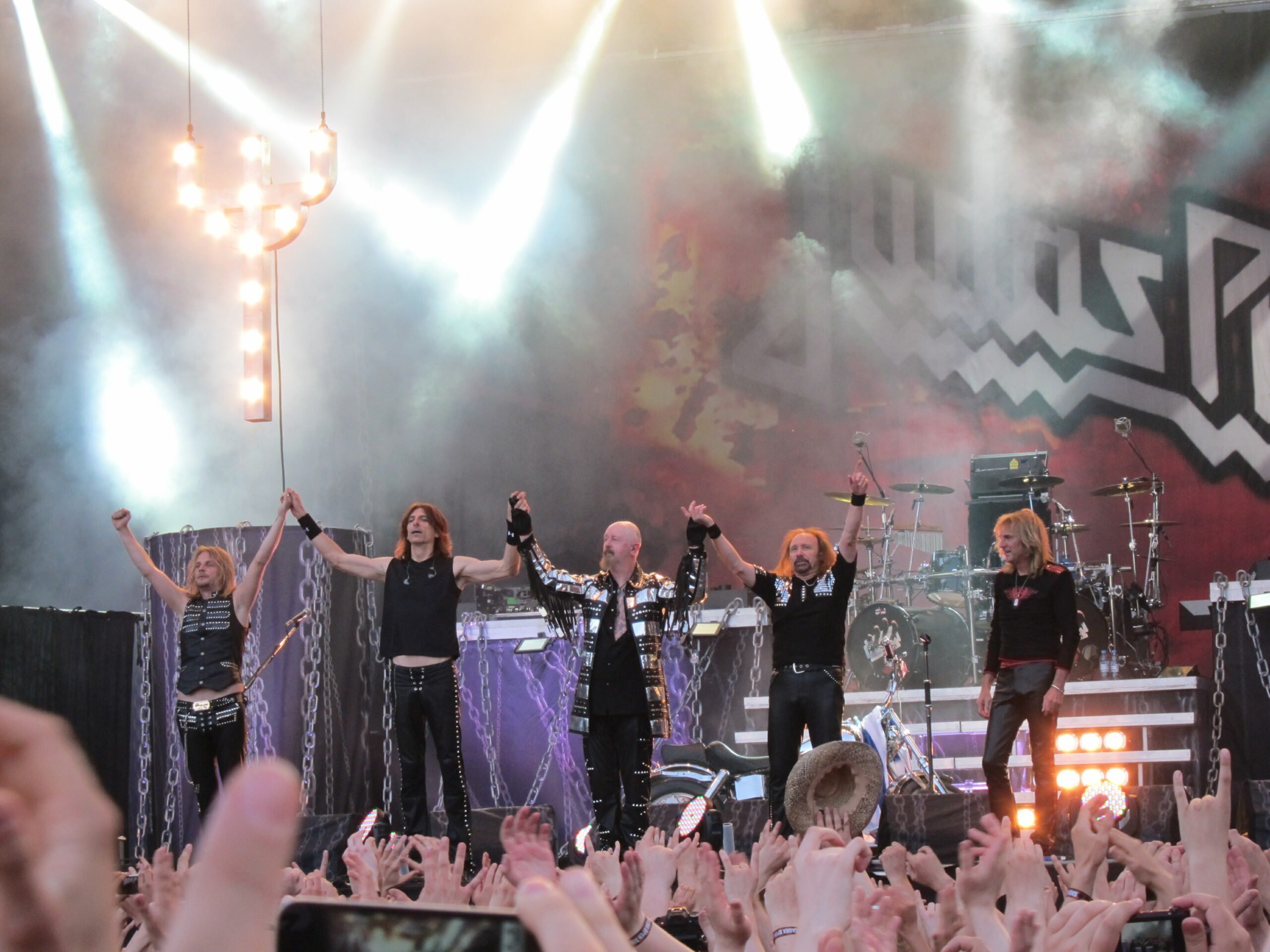All Guns Blazing
When people think of Heavy Metal, they think of black leather jackets, rivet-laced belts, howling motorcycles, and above all, loud, aggressive music. But of course, it didn’t just magically start that way. Someone had to go out there and break ground musically, culturally and sartorially, and one of those legendary bands was and still is Judas Priest. With songs like “Hell Bent for Leather”, “Breaking the Law” and “Painkiller”, they have left an unforgettable stamp on the history of Heavy Metal.
The beginning…
Judas Priest was originally founded back in 1969 in Birmingham, although no one from the original line-up was around long enough to play on any recordings. They did give the band its name though, inspired by Bob Dylan’s song “The Ballad of Frankie Lee and Judas Priest”. Al Atkins was on vocals, Kenneth Downing was the guitarist and Ian Hill was the bassist. They went through several drummers.

This Blues-Rock band had played a number of shows in the Midlands and had attracted a small following. Atkins left in 1973 and singer, Rob Halford, unsatisfied by his own band “Hiroshima” and intrigued by Downing’s determination to take Judas Priest all the way to the top, joined the band. It was a perfect match. Hiroshima’s drummer, John Hinch, also came along. They would have several more drummers though, over the remainder of the decade.
The mid-1970s were still the days of Glam Rock, Top of the Pops, Queen, cowboy shirts and flared trousers. Metal was a young, rather undefined genre, whose groundwork was just being laid by bands such as Black Sabbath, Deep Purple and Led Zeppelin. Judas Priest signed with the small independent label, Gull, and with the addition of Glenn Tipton as a second guitarist, they recorded their first album, 1974’s “Rocka Rolla” – and it was a massive disappointment, especially for the band itself. “It looked like shit, and was everything but Heavy Metal,” Halford would say in retrospect. The sound was lukewarm, the production half-hearted, and it received underwhelming reviews from music magazines. But while some bands enter music history with a bang, others have to gradually excel at what they do.
The band’s second album, “Sad Wings of Destiny” in 1976 became something of a modern classic. The title alone raised eyebrows. Halford, who was writing and would continue to write most of Priest’s songs, took his inspiration from a variety of historical and sci-fi literature. Musically they began focusing on heavier riffs and more complex drums. “The Ripper” is a perfect example of early Priest metal. “Sad Wings of Destiny” eventually charted, and after a successful tour, they were local celebrities.
“Sin after Sin”, their major label debut on CBS, is a darker, more apocalyptic album, with songs about epic battles between gods, devils and warriors, but Halford also began expressing personal feelings through his writing. The song “Raw Deal” was a hint to his homosexuality. “All eyes hit me as I walked into the bar. Them steely leather guys were fooling with the denim dudes. A coupla colts played rough stuff. New York, Fire Island.”
Being gay was far from being generally accepted at the time, and certainly not in the rock scene. Halford’s biggest fear was that the fans would turn their backs on Judas Priest because of it, or that the “scandal” would break the band apart, so he kept his homosexuality a secret for a large part of his career. But the suppressed feelings and the inevitable loneliness would eventually come to haunt – and nearly destroy – him.
Making it into the charts
However, the major fear back in 1977 was that no one would actually care for their album. At this point, Punk was the talk of the town, and every British magazine cover seemingly headlined nothing but Punk and more Punk. But with the marketing-power of a major label behind it, the album made it into the charts, and after selling out the Apollo Victoria Theatre in London, Judas Priest began their first of many US tours. As supporting act for the likes of Foreigner, Ted Nugent and even Led Zeppelin, the still rather unknown Judas Priest were suddenly playing in front of tens of thousands of people.
“Stained Class” in 1978 had a heavier, darker sound, but by 1978, the band also began to undertake a radical image change. Turning their backs on the cowboy shirts of the 70s, they instead embraced the heavy leather biker culture of Marlon Brando in “The Wild One”. Halford would spring on stage, wearing his leather cap and riveted gloves, and point a whip towards the front row. There was no “heavy metal look” really among the crowd in general then, and people usually wore the same clothes they would have worn to see Rod Stewart or Elton John, but Priest’s style caught on, and more and more of their fans began adopting it.
Musically the band was in peak form. For years it was a nonstop cycle of recording albums and going on tour. They were ready to take on the world. “Killing machine” once more delivered the goods, cementing the band’s new image as a sleek, unrelenting metal-machine. They climbed the charts and were seen on TV, with Halford driving his Harley onto the stage, delivering incomparable, high-pitched, Ringwraith-like screams, while Downing and Tipton unleashed unparalleled riffs and solos.
The Golden Age of Heavy Metal

Entering the 1980s, it was a golden age of Heavy Metal. New forms of sound engineering allowed better production and a heavier sound. The album, “British Steel”, was not only a commercial success, but a milestone in the band’s career. The song, “Breaking the Law”, heavily influenced by punk and the steam-hammers of the Midland’s heavy industry, was a harsh critique against Thatcher’s Britain, symbolising the feeling of millions of young people caught somewhere between hopelessness and rebellion. “British Steel” cut into the music scene like the razor blade on its cover, delivering a rapid fire of hits. Together with groups like Iron Maiden, Def Leppard and Saxon, the press hailed them as the “New Wave of British Heavy Metal”.
Halford was soon writing tracks for the following albums from the deserts of Arizona, which he had made his home. “Point of Entry”, “Screaming for Vengeance” and “Defenders of the Faith” became metal classics, and songs like “Heading Out to the Highway” were made to be listened to while driving, while “You’ve Got Another Thing Coming” embodies classic Priest themes of determination and willpower.
“The Filthy Fifteen”
But beyond that, the band was starting to run on autopilot. With sold out shows all over and heavy rotation on MTV, it was certainly the high point of their careers, but Halford himself was on a personal downward spiral, abusing alcohol and cocaine, and still suppressing his whole sexual identity, which caused isolation that contributed to the substance abuse. He grew irritable and had serious issues recording for 1986’s “Turbo”. His song writing became sloppy, resorting to traditional Rock n Roll cliches the band always avoided. In fact, it took a close encounter with death, after mixing a bunch of sleeping pills with Jack Daniels, for Halford to come to his senses. He’s been sober since that day.
Yet more trouble for the band was brewing. In Washington, the PMR (Parents Music Resource Center) and its co-founder, Tipper Gore, future Vice President Al Gore’s wife, began singling out music that they thought obscene for America’s youth. Judas Priest soon found themselves among the “Filthy Fifteen”. Although it definitely didn’t hurt album sales, it did put them on the radar of America’s conservatives and evangelicals.
Many see the 1990s as a gradual downfall of traditional Heavy Metal. New rock trends and metal genres were emerging as bands began to experiment with differing styles. Judas Priest, although a well-oiled metal machine at this point, had new competition – thrash and grunge drew huge crowds. With “Painkiller” and new drummer Scott Travis, the band aimed to release their most powerful and intense album. For Halford, it was to be their “Sgt. Pepper’s”, a musical benchmark to really set themselves apart from the rest. But before the album could be released, yet another tragedy struck.
The suicide pact
Back in 1985, after a night of heavy drugs and listening to “Stained Class” on repeat, two young men in Nevada had executed a suicide pact. Their parents and the US conservative media began blaming the tragedy on the harmful influences of Heavy Metal in general and Judas Priest in specific.
The band was sued over it in 1990. They were accused of their music having induced a hypnotising effect on the teens, in combination with alcohol and drugs, and that their songs hid subliminal messages like “Do it”, that enticed them to attempt suicide. The whole lawsuit was of course a farce, yet the acquittal was not as clear cut as one might imagine. It took a lot of time and nerve to convince the judge that Judas Priest’s message was positive, and that their songs had always been about the triumph of good over evil or of personal will over adversity. After that was settled, “Painkiller” could finally be released, and indeed, became one of their most acclaimed, if not the most acclaimed, albums.

However, instead of working on a sequel, the band was breaking apart. The decades of touring and recording had left Judas Priest exhausted, especially creatively, and tensions had grown within the band. Rob Halford’s decision to release material outside of Priest was the final impetus to him leaving the band. It seemed like the end, and it was for a couple years.
Tim “Ripper” Owens
In 1996, Tipton, Hill and Downing decided to continue the band, but without Rob Halford. Tim Owens was a massive Priest fan, and even played in a Priest tribute band called “British Steel”. Many high-profile singers were on the Halford replacement list, but after Owens performed the “Ripper”, the band had found their replacement. Many fans hardly felt a difference between Halford and the vocal performance of Tim “Ripper” Owens.
This line-up released “Jugulator” and “Demolition”, but was it Priest? The strong influences of bands like Pantera were undeniable, and stylistically, these albums were a big departure from before. By the time “Demolition” came out, many fans felt that the band’s sound had become too experimental; too heavily influenced by modern trends.
The reunion
Halford came out as gay in 1998, and Halford and Priest announced that it was time for a reunion in 2003. They toured again in 2004. Despite Owen’s undeniable talent, the Ripper did not stand a chance against the metal god. And in more ways than one, the album “Angel of Retribution” symbolised that Judas Priest was indeed rising once more. Despite the old-school sound, however, the band did not refrain from experiments. 2008’s “Nostradamus” became a symphonic power-metal concept album that split the fanbase, most either loving or hating it. Yet it also showed that Halford, Tipton, Hill and Downing, despite their advanced years, still had it in them to focus on everything that made and still makes Judas Priest great.
However, with KK Downing retiring from the band in 2011 and Glen Tipton sadly revealing in 2018 that he had been diagnosed with Parkinson’s and would no longer tour, the band’s old school live line-up was cut in half, with Halford and bassist Ian Hill left. But “Firepower”, their 18th studio album, was their first to crack the UK top ten since “British Steel”, so after a 50-year journey through Heavy Metal, the band continues on as strong as ever, still touring and still rocking. Judas Priest is still an unrelenting metal machine.
Check out the lyrics to our cover of Judas Priest’s ‘All Guns Blazing‘, which is a bonus track on our album, The Last Stand. Read the lyrics here.
If you’re interested in a more visual interpretation of the above story, watch our Sabaton History episode, Gods of Heavy Metal – Judas Priest:





















